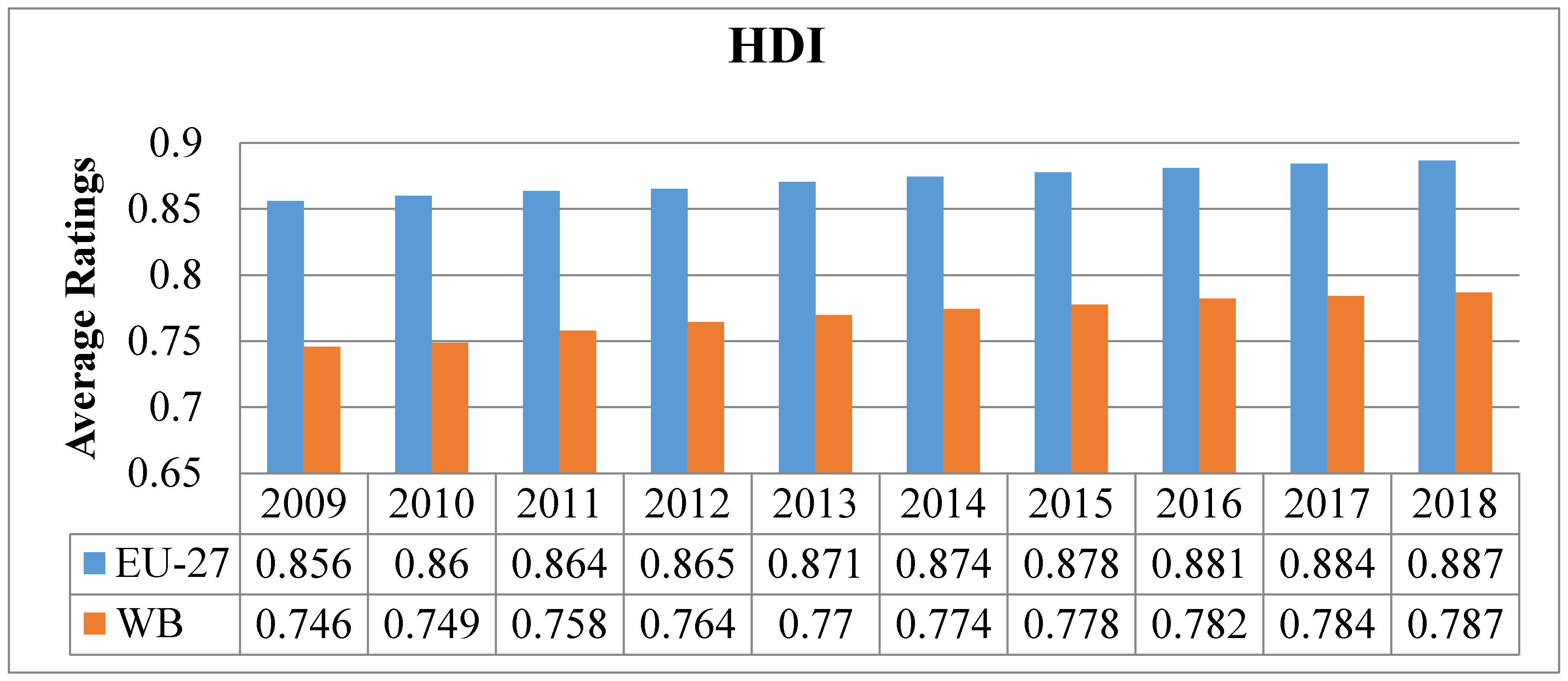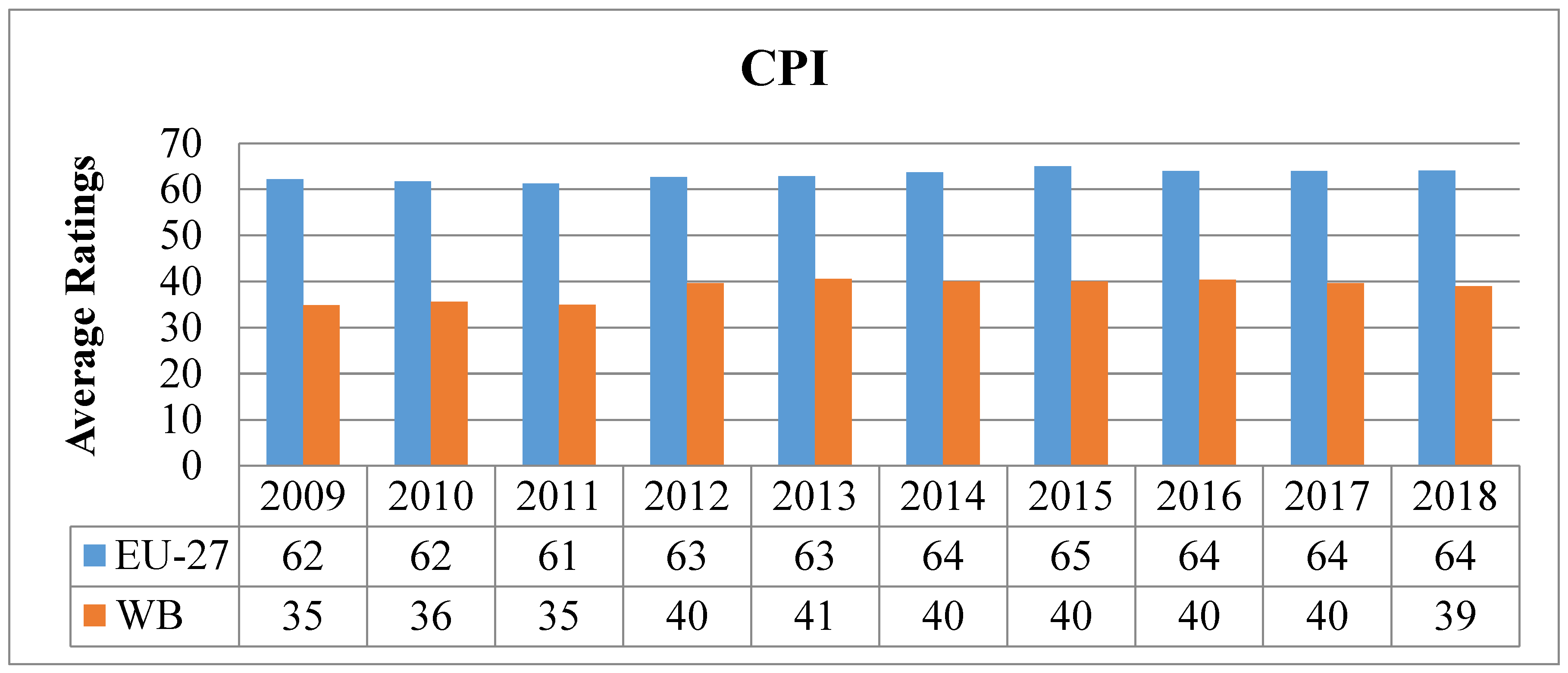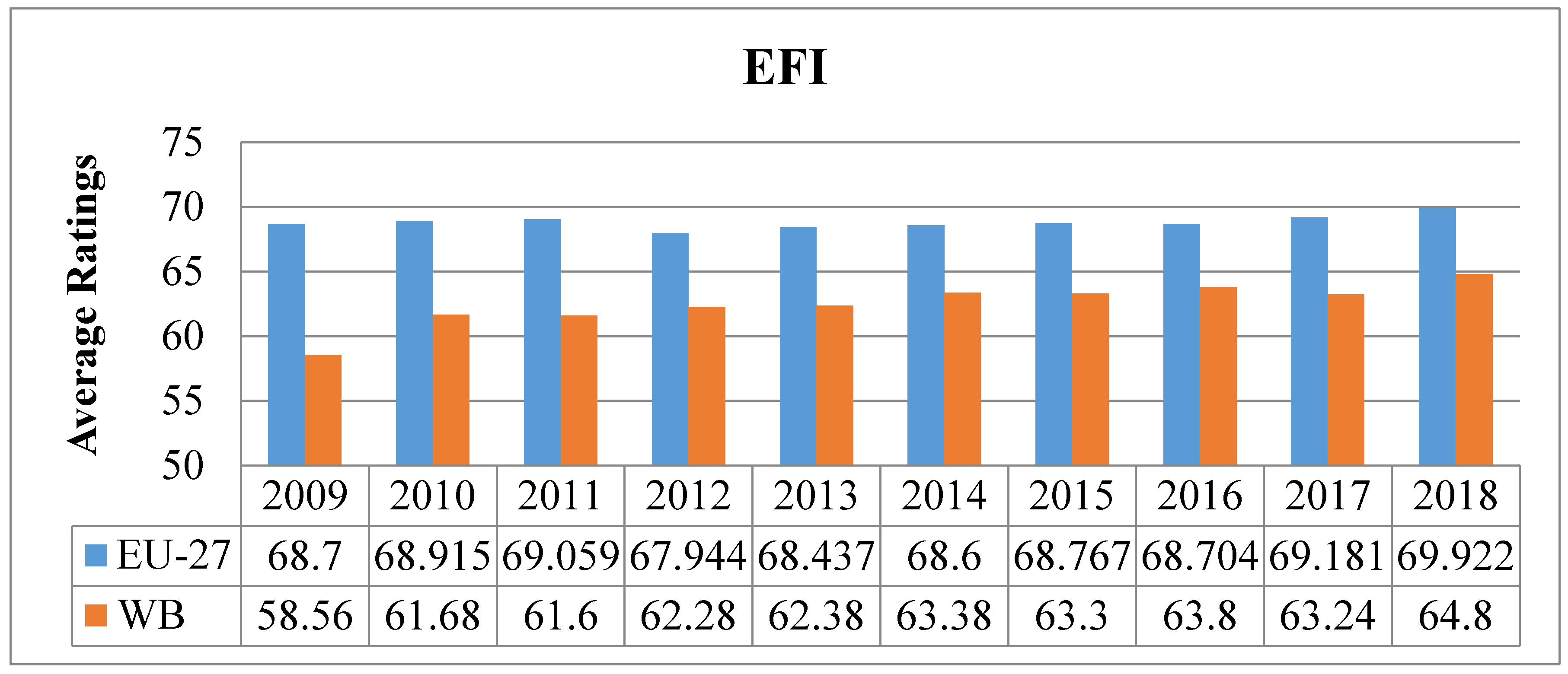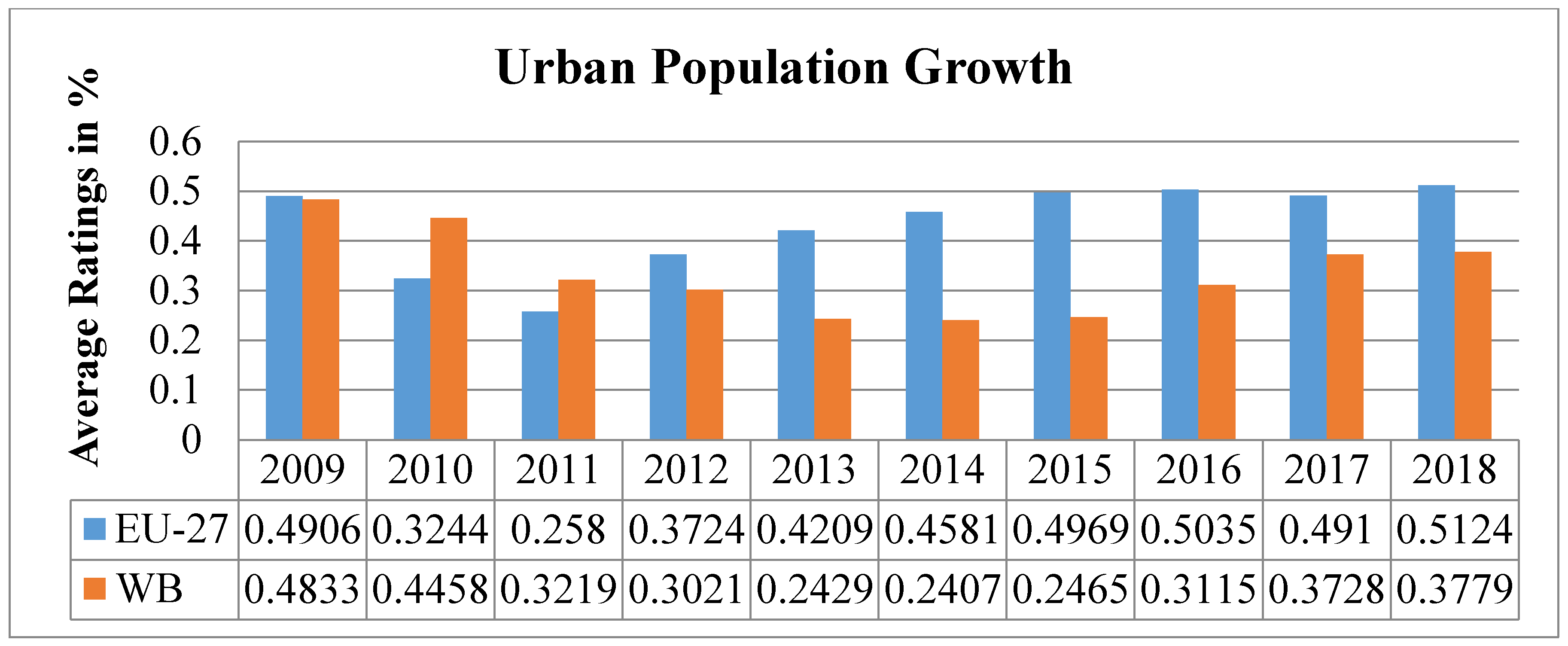Economic development is a process focusing on both qualitative and quantitative growth of the economy, centering human beings [
1]. Qualitative growth of the economy stands for the positive changes occurring in the human education levels and health standards, while the quantitative growth of the economy refers to the positive changes occurring in the income levels. Due to the nature of this multi-dimensional phenomenon, the economic development as measured by the HDI can be considered a better index compared to the economic growth, which is measured by GDP or GDP per capita, as the dimensions of HDI provide a broader picture of a nation’s well-being [
6]. Hence, considering the importance of economic development, scholars and researchers have conducted different studies to determine the factors behind different patterns of economic development, factors such as inequalities, poverty, crime rates, corruption, etc. However, based on the main objective of this paper, this literature reviews the relationship between corruption, economic freedom, urbanization, and economic development.
3.1. Corruption and Development
Corruption is the degradation of a nation, an oppressor of the social fabric of society, and a significant threat to justice and democracy [
26]. The literature provided over the years by the studies of different authors widely accepts the negative impacts of corruption on economic development. According to North (1993), corruption and development have an evolution characterized by an inverse progression considering the need for the existence of complex institutional structures that capture the possible gains from trade and that allow an impersonal exchange in time and space [
27].
Corruption is a model of social allocation with strong roots in a society that tends to be stable given that it depends on intrinsic power structures.
Akhter (2004), in his study on 1998 cross-sectional data of 75 countries of all income groups, empirically examines the relation between globalization and human development using a maximum likelihood method [
28]. The author claims that higher economic globalization raises the degree of economic freedom and also reduces the level of corruption, which, in effect, enhances human growth. Likewise, Asongu (2012), using a sample of 30 countries together with African development indicators, argues that globalization in terms of trade and finance applied to human development is a strong weapon to combat corruption [
29]. However, such a statement does not stand for low-income countries, because in these countries, the emphasis is placed on the economic dimension of international integration.
In addition globalization as a medium of reducing the levels of corruption and enhancing human development, Nielsen and Haugaard (2000) argue that a consolidated democratic system would help in lowering corruption levels, which, in turn, will correspond to higher levels of human development [
30]. Using OLS cross-country estimates, the authors claim that greater public services and more government involvement contribute to higher rates of corruption, and it seems possible that corruption not only decreases growth, but it also lowers social spending on education, which is detrimental to human development and productivity. In addition, Akçay (2006) claims that corruption hinders growth, which, in turn, leads to lower GDP per capita. At the same time, corruption lowers spending on education and health, while the decline in the GDP per capita is associated with adverse impacts on living conditions, life expectancy, and human capital accumulation. As a result, the human development level will decline [
31].
However, the magnitude of the impact of corruption on a nation’s welfare differs from one country to another. Similarly to previous studies, Mendonça and Fonseca (2012) argue that corruption hinders growth, as they find strong statistical evidence for a negative impact of corruption on the GDP per capita, an impact that is greater for the developing countries than the developed ones [
32]. Hence, improving the CPI will result in a greater positive impact in developing countries as compared to developed countries. Mariyono (2012) suggests that the government should take the needed measures, such as preventive and repressive actions to annihilate corruption, the impact of which is more destructive in developing economies due to dysfunctional institutional factors, while, in general, an increase in the corruption levels causes worse conditions in a nation [
33]. Similarly, Letaio (2016) argues that the government agencies in developing countries are often more corrupt and less effective than the ones in developed countries; thus, as a result, the consequences will be higher for developing countries [
34]. Hysa and Çela (2019) emphasize the importance of good governance, as they find a positive relationship between good governance indicators and human development [
35], supported by Mansi, Hysa, Panait, and Voica (2020), who argue that a good political state influences better economic policies and better harmony in well-being [
36]. While Peyton and Belasen (2010) agree on the negative impact of corruption being higher for developing countries [
37], Adhikari (2015) declares that countries with higher corruption levels are those that have lower levels of human development; in other terms, developing countries tend to be more corrupt than developed countries [
38]. Lastly, Akhbari and Nejati (2019) emphasize that by lowering corruption levels, the environmental quality, which has an impact on human health, gets better, an impact that is higher for developing countries than for developed countries. Taking into consideration the negative impacts of corruption, the authors agree that it is of great importance to find ways to mitigate this impact [
39].
Popescu, Duțulescu, and Nișulescu-Ashrafzadeh (2019) argue that corruption activities will vanish only if the causes that generated corruption in the first place disappear [
40]. However, considering the EU countries, the authors believe that the problem of corruption is very difficult to control and fully eradicate, irrespective of the efforts made in this regard, as there are political, economic, social, and cultural ties between the EU countries and other countries around the world that are considered as highly corrupted. Still, they conclude that a country with a very low level of corruption must have a strong economy and high living standards. In other words, there is an indirect relationship between corruption and human development. Furthermore, Sarabia, Crecente, del Val, and Giménez (2019), in their analysis of the EU-28 countries for the period 2013–2017, find a high correlation between the HDI and the level of corruption because of the social conflicts that arose among EU citizens as a consequence of the 2008 crisis [
41].
Similar studies related to Western Balkan countries are limited in number. Hysa (2011a), in her study on the Western Balkans for the period 2002–2010, argues that the negative relationship between corruption and human development is strong in Serbia, Montenegro, Albania, and Former Yugoslav Republic of Macedonia, weak in Croatia, and insignificant in the case of Bosnia and Herzegovina [
4]. Furthermore, in her second study, Hysa (2011b) provides a comparative analysis between Albania and the EU-27 countries for the same period [
10]. The findings reveal the negative relationship between corruption and human development for both cases; however, the results suggest that this relationship is much stronger for the Albanian case. Mazllami (2019) provides a comparative analysis of the relationship between the HDI and CPI for Macedonia and Albania for the period 2006–2016 [
11]. The empirical results suggest that improving the education levels, health conditions, and standards of living will result in the mitigation of corruption levels in Macedonia, but not in the case of Albania. In other words, the reverse relationship proved to be true only for Macedonia. However, this study has a major limitation, that of the small sample size.
Leaving aside the negative impacts of corruption, the literature review finds evidence of other approaches as well. Heckelman and Powell (2010) argue that corruption has a positive impact on economic growth in those countries that have low levels of economic freedom, as corruption allows entrepreneurs to stay away from inefficient policies and regulations; as a result, these entrepreneurs bring new investments into the economy, which will highly likely result in greater economic growth [
42]. Moreover, corruption is considered an incentive for the foreign direct investment (FDI), as it helps firms to avoid formal regulations by attracting transactions that, in other terms, are considered inappropriate, while the FDI itself has a positive impact on the economic growth in countries in which the corruption levels are above the threshold level [
43,
44]. Furthermore, countries that are dealing with political instabilities and ineffective institutions may face higher levels of efficiency, as corruption removes conditions that hamper economic development [
45,
46].
There are certain contexts in which corruption can be beneficial for economic development when the government cannot promote economic activities [
47]. Entrepreneurs could use corruption to target bureaucratic support for areas with the greatest growth potential. In this way, an element of competitive bidding could be introduced through which the entrepreneur who offers the biggest bribe would win public resources. Fernández, Gutierrez, and Ramajo (2018) provide evidence in support of the “greasing the wheels” hypothesis by arguing that greater control of corruption means that the number of procedures, number of days, and cost of starting a business have greater negative effects on economic growth [
48].
Hoinaru, Buda, Borlea, Văidean, and Achim (2020) argue that corruption may be seen as a way of avoiding the law to attain greater economic benefits, and hence to increase economic development [
49]. Even though the authors find evidence for the positive impact of corruption on the economic development of low-income countries, generally speaking, they emphasize the importance of fighting the phenomenon of corruption. Likewise, Jiang and Nie (2014) support the idea that corruption may help private firms to avoid the law, as a result of which their profitability will be higher [
50]. Additionally, they mention that there are countries like China where, even though they have highly corrupt governments, their GDP growth rates are increasing tremendously. However, Ahmad, Arfeen, and Ullah (2012), by using panel data on both developing and developed countries, provide evidence that the relationship between corruption and economic growth can be expressed with an inverted U-shaped curve, meaning that a decline in corruption levels will increase the economic growth in an inverted U-shaped way [
51].
3.2. Economic Freedom and Development
Development is about creating freedom for people and removing obstacles to greater freedom, thus enabling people to choose their destiny [
52]. Wallich (1960), in his book “The Cost of Freedom”, reflects the traditional wisdom of that time, which emphasizes the importance of government interventions, such as increasing regulations and taxation as a means of lowering unemployment and having a fair distribution of income [
53]. The author considers the loss of economic and personal freedom as something worth achieving as policy goals. However, his student, Grubel (1998), argues that economic freedom is not related to economic costs; instead, it provides economic benefits [
54]. Based on his analysis, he argues that higher economic freedom is associated with lower unemployment levels, higher levels of human development, and higher performance of all the criteria of human well-being.
Madan (2002), in her study of 152 countries of different categories of income, argues that the greater the economic freedom of a country, the greater the quality of people’s lives in that country; however, her empirical results suggest that as economic freedom increases more quickly, the human development suffers [
55]. Still, the insignificance of such a result makes it possible to conclude that what matters for socioeconomic development is the level of freedom and not the pace of change. Additionally, the author argues that at the beginning of the process of becoming free, countries face greater income inequalities, and after some time, they start to benefit from economic freedom. Moreover, Claessen and Bellavitis (n.d), in their study of 66 developing countries for the period 1998–2007, observe a change in the sign of the relationship between human development and economic freedom for middle-income countries when performing the robustness check [
56]. As a result, they provide no general conclusions on the relationship between human development and economic freedom, other than that it tends to be a positive one.
Likewise, Akhter (2004) argues on behalf of the positive relationship between economic freedom and economic development [
28]. The author contends that a higher degree of economic freedom implies greater incentives for business transactions in combination with the legal security of the property. Moreover, a higher degree of economic freedom contributes to higher standards of living, and as a result, the demand for goods and services, both domestically generated and imported, would be higher. Vondrová and Fifeková (2016) state that the fundamental criteria of economic freedom are the political and civil rights that each individual enjoys, and as a result, the quality of a person’s life is greatly determined by these criteria [
57]. Using a nonparametric approach for the European countries, the authors contend that countries can enhance their economic performance by increasing the level of their economic freedom. The authors suggest that improvements in property rights are a potential source of economic development for all countries. Still, Chang (2007) argues that it is important to clarify what is considered a “good” property rights system in order to be able to identify the exact conditions under which particular institutions help economic development [
58]. However, not all countries benefit the same from economic freedom; countries with the least human development benefit more from improvements in economic freedom [
59]. Using the conditional quantile regression method for 88 countries, the author argues that at a lower level of HDI distribution, economic freedom appears to have a pronounced influence, and then settles down from the middle to upper quantiles. Similarly, Gehring (2013) suggests that developing countries tend to benefit more from economic freedom than developed countries in terms of higher well-being due to the adaption effects in developed countries; thus, economic freedom tends to have a larger impact on the well-being in developing countries than in developed ones [
60]. The author suggests that to increase economic freedom in developing countries, it is important to reduce unnecessary regulations. Furthermore, Corbi (2007) declares that, in particular, countries with low levels of income are the ones that grow rapidly when their policies encourage economic freedom, which is of high importance for achieving prosperity [
61].
Contrary to the previous studies, which have widely used the HDI as a measure of economic development and human well-being, Graafland (2019) examines the relationship between economic freedom and well-being by using 11 dimensions of the Better Life Index provided by the Organization for Economic Co-operation and Development (OECD) [
62]. The author argues that this relationship is moderated by long-term orientation. He finds a positive relationship for most of the well-being indicators and a negative relationship between leisure (work–life balance) and economic freedom. Still, the results suggest that long-term orientation diminishes the negative relationship between these two variables. The author concludes that economic freedom is particularly related to well-being in a cultural environment where people exhibit virtues that enable them to engage in future-oriented behaviors, and this long-term orientation helps them keep a balance between their work and their life.
3.3. Urbanization and Development
Urbanization referrers to the process by which more and more people leave the countryside to live in cities [
23]. Over the years, researchers have conducted different studies on the impact of urbanization on economic development. As the results of the various studies are contradictory, the debate remains open about whether urbanization has a positive or negative impact on the development of a country.
Njoh (2003) studies the relationship between urbanization rates and the HDI in the countries having a Stabilization and Association Agreement (SAA), basing his hypothesis on the modernization theories, which see urbanization as part of a natural process that provides positive outcomes for societal and national development [
63]. Forming two different groups of countries, in which one has higher urbanization rates than the other, the author finds out that the one with higher urbanization rates tends to perform better in terms of human development, indicating a positive relationship between the chosen variables. Similarly, Akçay (2006) sees urbanization as a natural part of the development process, and by taking into consideration both developing and developed countries, he argues that residents in urban areas not only have more opportunities for greater incomes, but also greater access to education and services such as healthcare and other social services, meaning that in urban areas, there is a higher human development than in rural areas, as urbanization tends to increase human development [
31]. Duranton (2014) argues that for both developed and developing countries, there is a positive impact of the city’s size on the outcomes of the productivity (income levels), an impact that is small for both cases, but higher for the developing countries [
64]. Additionally, Bertinelli and Zou (2008) emphasize the role played by cities in stimulating human capital accumulation [
65]. The emergence of a greater number of urban dwellers appears to support the development of human capital within a delay of five years, even after the authors controlled for the general levels of development: GDP per capita, life expectancy, and fertility. The authors argue that cities serve as an ether, where barriers to the flow of information and knowledge diminish and closeness among people supports connections that could be the core of human capital spillovers. In exchange, opportunities to fund education are increased, leading to higher rates of education and bettering people’ lives. Odugbesan and Rjoub (2020) conducted a study for MINT countries using data from 1993 to 2017 and employing the autoregressive distributed lag (ARDL) Bounds test approach. The study was focused on the relationship between economic growth, CO
2 emissions, urbanization, and energy consumption. The authors proposed a solution for sustainable urbanization in MINT countries by ensuring the reduction in the urbanization level through the public authorities without compromising the economic growth. So, the aim is green and intelligent urbanization [
66].
Likewise, the empirical results of the study that Huang and Jiang (2017) conducted on Inner Mongolia for 2000 and 2010 suggest that higher urbanization rates are associated with higher values of the HDI, even after controlling for the possible effects of GDP [
67]. The authors emphasize that both GDP per capita and HDI scores are higher in urban districts than in rural counties of the same prefecture, supporting the claim that cities perform better in terms of economic and social development as compared to their surrounding rural areas. Mayer-Foulkes (2012) declares that urbanization is one of the most significant determinants of the HDI, as it has a positive significant impact on each of the HDI’s components; however, it appears that urbanization has a higher impact on middle-income countries, which can make it a development tool [
68]. Authors argue that as urbanization tends to improve human development, it is important to promote balanced urbanization. To obtain the maximum benefits of urbanization, sustainable urbanization that involves sufficient delivery of basic services, such as infrastructure, electricity and water, medical facilities, etc., is needed to ensure that the process of urbanization is consistent with the principles of sustainable development [
69,
70].
Contrary to the previous findings, Moore, Gould, and Keary (2003) argue that even though cities offer greater opportunities for better education, jobs, and healthcare, they put human health at risk when there is a fast and unexpected urban growth [
71]. Such a development within the developing world is often tied to deprivation of the basic needs, environmental devastation, demand surpassing service supply at a great scale, air pollution, contaminated drinking water, inadequate sanitation, and substandard housing, all of which tend to lead to different diseases, putting human health at serious risk. Likewise, Eckert and Kohler (2014) emphasize that in developing countries, population density is high while sanitation conditions are not at their best levels; as a result, urbanization is associated with various health conditions, some of which may be improved, while some others may get worse [
72]. Szabo (2016) argues that rapid urbanization has a negative impact on food security; the less secure the food provided to the people of a country is, the more exposed are these people to health risks, a phenomenon that is more common in countries with the lowest values of human development [
73]. Similarly, Dociu and Dunarintu (2012) argue that developing new urban areas without following appropriate steps to develop sustainable areas would have a negative effect on the environment with serious consequences for human health. Additionally, the authors emphasize that the impact of urbanization is greater for less developed states [
74].
Still, Martínez-Zarzoso and Maruotti (2011), in their study on developing countries, argue that once urbanization has reached a certain level, its impact on CO
2 emissions will turn out to be negative, leading to a reduction in environmental harm [
75]. Moreover, the authors highlight that the benefits associated with urbanization surpass the disadvantages. For developing countries to minimize the costs associated with urbanization and to be able to gain from the benefits that it brings, it is important to create adequate urban planning policies, aiming to achieve urban sustainability [
76].









